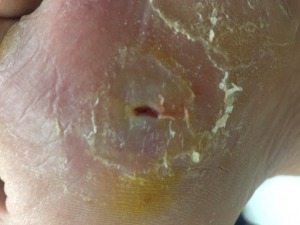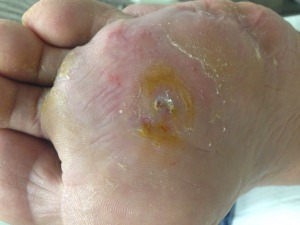Diabetic Foot Ulceration
Diabetic Foot Ulceration
Diabetes is becoming more common in our society. According to the National Diabetes Statistics Report,
almost 30 million Americans in 2012 had diabetes. Diabetes can have a huge impact on your foot health.
Long-term poor blood sugar control can affect the vascular system in your foot by damaging the blood
vessels. This can decrease your ability to heal any injury or ulcer to your foot.
Another complication of uncontrolled diabetes is peripheral neuropathy. This decrease in sensation can
prevent a patient from detecting trauma or increased pressure to the foot. As a result an ulcer can
develop and worsen before you realize there is a problem. Ulcers can be treated conservatively (non surgically) however
sometimes they require surgical intervention in order to heal. Below is a case of patient treated and healed
with strictly conservative treatment.
A patient presented to my office with a diabetic foot ulceration that had been present for 18 months
without much progress in healing (see picture below).
The patient was treated with strict conservative care which included daily dressing changes, the patient
being non-weight bearing the foot with a knee scooter, and debridements of the excess callous build
up.
In just 3 weeks the patient’s ulcer had improved by 87.9%.
And just 7 weeks after starting treatment, the patient is now healed (see pic below).
With good conservative care by both the patient and physician, a diabetic foot ulcer can be healed. This
patient wished to avoid surgery and therefore had excellent compliance to the treatment plan. He will
be placed in custom orthotics to help offload the area and continue to follow up with me to ensure that
the ulcer does not recur.
Here are a few tips to help diminish the development of a diabetic foot ulceration.
Maintain consistent good blood sugar levels. This will help prevent development of vascular
disease and peripheral neuropathy
Check your feet daily. This will allow you to catch a small problem (like a cut or callous) before it
becomes a big problem (like a diabetic foot ulceration).
If you do have peripheral neuropathy, never walk barefoot. This can keep you from stepping on
things without your knowledge that could progress to an ulceration.
See your doctor once a year for a foot check. At this appointment your sensation, pulses, and
skin can be checked for any potential problems.



